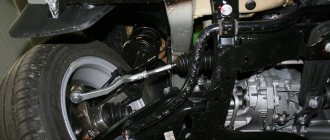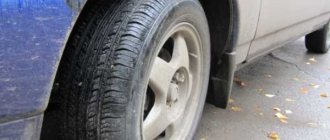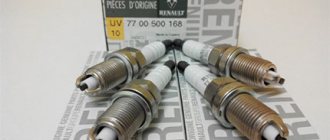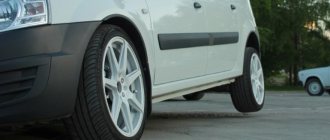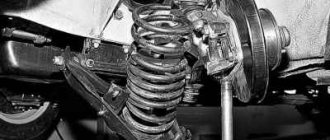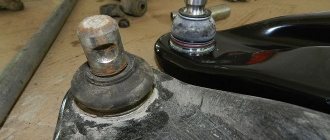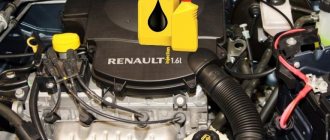Front suspension device Lada Largus
So, the front suspension of the Lada Largus has a similar structure to the Renault Logan MPV van, since the entire car was made entirely on its basis. In fact, the front suspension is independent of the MacPherson type and is built around a full-fledged subframe, which has not been done on the Lada before. Shock absorbers are conventional telescopic gas-oil, springs are cylindrical screw.
Below are the right and left levers on two silent blocks and a ball, as well as a stabilizer bar.
The subframe itself is attached to the side member of the engine compartment and the power units of the engine shield using bolts.
In essence, the design of the front suspension on the Lada Largus is as simple as possible, but as reliable and efficient as possible, which makes servicing this unit inexpensive and fast.
Below in the diagram you can see how the front suspension on your Lada Largus is designed.
Ways to increase the clearance of Largus
The domestic station wagon is very popular due to its unpretentiousness and reliability. One of the important indicators is solid ground clearance. Transporting goods with these vehicles is a common occurrence. And this inevitably leads to an increase in the load on the suspension, namely on the shock-absorbing struts, which sag due to weight, resulting in a decrease in ground clearance.
We must not forget the quality of Russian roads. It is sometimes impossible to move through potholes and potholes without damaging the suspension. In any case, the amount of ground clearance in this regard is crucial. Because of these factors, many Largus owners try to increase the ground clearance with their own hands. Today there are several ways to do this inexpensively and quickly.
Increasing ground clearance with your own hands
In order to increase ground clearance (suspension lift), car owners use several basic techniques:
- installation of wheels or tires with a larger radius;
- installation of special spacers for shock-absorbing struts;
- replacing the springs with stiffer ones, as well as installing extended shock absorbers.
Some people use air suspension for these purposes. From the point of view of rationalism (and Largus is mainly used by people who prefer the practicality of a station wagon), this is unjustified. Firstly, the equipment is expensive, and secondly, not every car owner can install air suspension with his own hands. Plus, the compressor and receiver will take up useful space in the trunk, which is again impractical.
This type of suspension tuning is not popular.
Front suspension arms Lada Largus
The front suspension design of Largus uses two triangular arms - right and left. They are based on two silent blocks that secure the lever to the subframe, as well as one ball joint connecting the lever and the steering knuckle. This is one of the most vulnerable components of the Largus front suspension, as it takes all the impacts, as a result of which the ball joint breaks and the silent blocks wear out.
In early Lada Largus models, the ball joint was changed separately, and in relatively new ones - only together with the lever. Silent blocks can be changed without problems and buying them is not difficult.
Article numbers of the front levers: 6001547520 (left, assembled) 6001547519 (right, assembled).
Noises while driving
As already noted, the main threat to the good condition of the Lada Largus suspension is uneven roads. Often, a knocking sound in a certain unit appears after the wheel falls into a hole or hits a bump. Here the situation can be aggravated by the inexperience of the LADA Largus driver. A late noticed symptom of a malfunction can develop wear on parts mating with the worn component. Sometimes the source of the knock can be a banal loosening of the fastener of a chassis element. You cannot continue moving, because without taking measures, the weakened part will quickly break (ball joint, silent block, etc.) or become deformed.
Front suspension subframe Lada Largus
The Lada Largus subframe is a stamped-welded square that serves as a frame for the remaining elements of the front suspension. The subframe is attached to the body with 4 bolts, and at the rear the subframe has fasteners for the anti-roll bar. Also at the edges, levers are attached to the subframe with two bolts on each side. The subframe looks like this:
Conclusion
Of course, detailed diagnostic procedures and timely elimination of the causes of the malfunction will allow you to quickly repair the suspension. In this matter, it is better to trust the specialists of service centers, who will help prevent major repairs by replacing some components or tightening the connections that secure them.
It’s easy to understand how important suspension is in a modern car by taking an ordinary cart as an example. As a rule, driving on bumpy roads on it is not synonymous with comfort. In order to smooth out all the irregularities and dampen vibrations as much as possible, rear and front suspensions were invented. In addition, this system connects the wheels to the body.
The purpose of all pendants is the same. But the design features are different. For example, Lada Largus is a representative of the budget class on the B0 platform and has a simple suspension arrangement.
Front suspension shock absorber Lada Largus
The front suspension shock absorber (or strut) is attached to the steering knuckle from below with two bolts and from above through a support to the wing cup. Serves to absorb shocks from the suspension, ensuring a smooth ride. For a smooth return to the starting position, a coil spring with the same pitch of turns is used. Just like the lever, the shock absorber is subject to wear, as it takes impacts from the wheels.
Replacing the front strut does not present any difficulty, as we wrote about in one of our articles.
Performance
The Lada's suspension is moderately stiff, but the car does not shake on bumps and potholes; it drives confidently along the highway.
Although Largus is not an SUV, it overcomes difficult sections of roads well, to a large extent this depends on the ground clearance, and it is quite large here - 145 mm.
The car is easy to drive; you don’t need to make any effort to turn the steering wheel.
Outside the city, the average gasoline consumption is approximately 8 l/100 km, in the city - an average of 10-11 l/100 km.
In winter, taking into account warming up and traffic jams in the city, it can take up to 13 or 14 liters; another extra liter is spent on cars with air conditioning.
With a 102-horsepower engine, the station wagon accelerates to hundreds in 13.1 seconds, with an 87-hp engine. With. the result is somewhat more modest - in 14.2 seconds.
The maximum speed also depends on the power of the power unit, and is equal to 165 and 158 km/h, respectively.
Speed characteristics can be called average, but Largus is not designed for racing, its task is to transport cargo and serve as a family car.
Anti-roll bar Lada Largus
This unit serves to reduce body roll and sway when turning and sharply changing lanes. It is a rod made of elastic metal that works in torsion. Attached to the subframe through bushings and to the right and left arms through special stabilizer struts. The struts and bushings are consumable parts that need to be replaced when worn. The stabilizer itself very rarely requires replacement.
Front and rear unit malfunctions
Lada Largus is considered one of the most popular domestic cars. The first of its main advantages is its “indestructible” suspension. But despite its high reliability and durability, the system will sooner or later need maintenance and repair. Thanks to this, it will be possible to extend the life of the suspension and prevent failure of other elements. You can avoid unpleasant consequences and costly repairs by identifying faults correctly and in a timely manner.
Signs of problems with the subframe on Largus
In the case of this element, you need to understand that it serves as the basis of the front suspension. And identifying its malfunctions in a timely manner means avoiding more serious problems, including replacing a failed unit. Not only the suspension arms, but also the exhaust system cushions, as well as the rear part of the power plant are attached to the subframe.
Wear or damage to the suspension subframe can be easily determined independently by some characteristic signs. For example, the main indicator is the play in the places where attachments are attached. In addition, a knock from the front will indicate a malfunction (a knock is generally a characteristic sign of problems with the suspension).
Problems with the subframe can also be indicated by wheel alignment/camber problems.
Signs of faulty shock absorber struts
These parts are designed to level the car while driving. And also to ensure smooth suspension movement when hitting various obstacles and uneven surfaces. Shock absorbers and springs prevent the body from swaying too much and also provide vehicle clearance.
Malfunctions of shock absorbers and springs can be easily recognized by the following symptoms:
- oil leaks;
- strong body swaying when hitting obstacles;
- vibration, squeaks and knocking when moving;
- controllability decreases;
- strong shocks and impacts (suspension breakdown) when falling even into small holes.
An equally important role in the suspension is played by springs, which have their own characteristic symptoms of malfunctions. These include reduced ground clearance, jolts and strong swaying when hitting obstacles. When the coils of springs break, you can notice how the body tilts in one direction or another when the car is standing on a level surface.
Signs of a malfunctioning stabilizer bar
This element is designed to maintain vehicle stability in a flat plane and prevent the body from swaying. The stabilizer functions together with levers, with the help of which it is attached to shock absorber struts and hubs. The part is quite durable, but due to natural wear and tear, the time comes to replace the suspension stabilizer.
The malfunction of this element can be diagnosed by a number of general signs and some special symptoms.
| What's happening: |
In what situations:
An important part of the suspension is the levers, with their help the angle of rotation of the drive wheels is limited. The lever is connected to the steering knuckle through a ball joint. This element itself is a metal tube bent in a certain way. Accordingly, it fails very rarely.
Malfunctions associated with suspension arms will most often be the result of wear or damage to the silent blocks with which the arms are secured.
Malfunctions can be identified by the following signs:
- imbalance of the drive wheels;
- knocking when hitting obstacles;
- While driving, the car pulls to the left or right.
In addition, if there is a problem with the levers, noticeable play in the steering appears. Similar symptoms occur when the hub or steering knuckle malfunctions. These elements are subject to heavy loads during vehicle operation and therefore also often fail due to wear. If there are problems with the hub or steering knuckle, the car is pulled in different directions when driving, tire wear becomes uneven, and a squeaking sound appears when the steering wheel is turned.
Suspension diagnostic methods
This is a mandatory procedure before carrying out repairs. It allows you to identify components and elements that require replacement. The algorithm for checking the suspension is as follows.
- First you need to inspect the shock absorber strut supports. The distance between the top of the support and the glass ideally does not exceed 1.5 cm.
- The steering wheel should rotate without force in both directions (creaking, crackling or delay, as well as play indicate a malfunction).
- Rock the car in different directions from all angles: if there are no problems with the shock absorbers, the body should swing no more than two times and take its original position.
- Try to swing the rods, balls and levers from side to side. There should be no backlash.
Suspension diagnostics are carried out only on level ground.
You should also carefully inspect the silent blocks. They should not have cracks, delaminations or tears. For a more detailed check, experts recommend using an overpass or inspection hole. This way you can carefully inspect the subframe and anti-roll bar for damage and deformation. Most suspension parts (with the possible exception of shock absorbers) cannot be repaired. Will need replacement.
Installation of wheels with a larger radius
Largus comes standard with 15R wheels. Many motorists choose the 16 or 17 radius option instead of the one proposed by the factory. Additionally, this makes the car's exterior more attractive. However, this option also has a significant drawback, namely the unstable position of the car when driving, as well as malfunctions in the ABS system and some related sensors.
Installation of spacers
The most budget option (and popular) is to install special spacers, which are sold at any auto parts store. The only thing that is required from the car owner is the removal of the suspension struts. The parts themselves are unified and suitable for many VAZ cars. Spacers are installed between the rack and the body bowls (as an option - between the beam and the rack).
Replacing strut parts
One of the best methods for increasing ground clearance is to install stiffer springs and longer shock absorbers. As a rule, such racks are approximately 20 mm longer than standard devices. In combination with reinforced springs, they are able to significantly increase ground clearance, and the car does not sag all the way when transporting the maximum permissible weight of cargo. The only drawback is the higher price of such kits.
Repairing the suspension yourself and increasing the ground clearance on the Lada Largus is easy to do if you have at least minimal car repair skills. If you have never done this before, it is still recommended to carefully study the instructions. And if you are unsure of your own abilities, it is better to turn to qualified car service specialists.
| metallic knock; | when driving over uneven surfaces; |
| big roll; | when passing sharp turns; |
| the body sways strongly; | during sudden braking. |
Additional control options:
- It is possible to install a control system with adjustment from the passenger compartment
- The system can be installed on 1 circuit (total airbag pressure)
- On two circuits (different pressure in the cushions, reduces sway, allowing you to independently level the left and right sides)
- The ability to additionally install a compressed air receiver to increase the speed of operation (pumping) of the air suspension, as well as add the ability to connect pneumatic devices, such as tire inflation or a pneumatic signal
